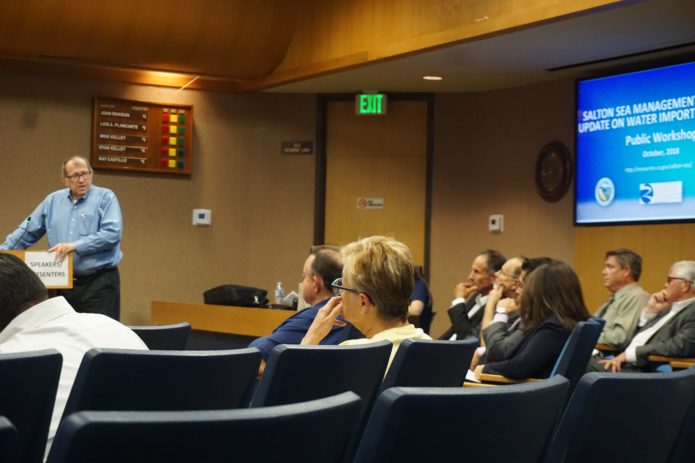
Bruce Wilcox, assistant secretary of the California Natural Resources Agency in charge of Salton Sea Policy, welcomes attendees to the workshop held Oct. 4 in Imperial County to discuss three proposals for importing water to the Salton Sea. Those three proposals have been deemed the most complete to move forward to another round of evaluations.
On Thursday Oct. 4, the California Natural Resources Agency (CNRA) hosted a second round of discussions about the concept of importing water to the Salton Sea for long-term restoration under the State’s Salton Sea Management Program (SSMP). The workshop, held at the Imperial County Board of Supervisors chambers in El Centro, was a follow-up to a workshop held earlier in the year when 11 firms presented their concepts for a water importation plan. All eleven were proposed in response to “request for information” issued by CNRA. According to Bruce Wilcox, assistant secretary for CNRA in charge of Salton Sea policy, the original list was whittled down to three proposals, all of which were deemed the most complete to move on to further rounds of evaluation. Those three were presented to the public during the Oct. 4 workshop and a similar workshop held in Riverside County earlier in the week.
Wilcox told the public that an evaluation committee had been organized to review all eleven proposals, and it was that committee that narrowed the list down to the three that apparently will move on to a next phase. That committee consisted of members from Imperial County, Coachella Valley Water District, Salton Sea Authority, Riverside County, the Regional Water Quality Control Board, the Bureau of Reclamation, Earth Systems (a geo-technical company), and an advocacy group. Wilcox said that committee has now dissolved, and a new committee may be formed to further evaluate the three remaining projects. He also said the next steps could involve meeting with legislators to discuss potential next steps. A key point to remember is that CNRA remains focused on the more immediate Phase One of its SSMP, which calls for addressing up to 30,000 acres of exposed playa over the next ten years with habitat and air quality projects. There currently is no funding set aside for construction of a water importation program, which, according to the projects presented, could cost anywhere from $3 billion to $8 billion to construct with millions in annual operation and maintenance costs.
The goal of this blog is not to discuss the merits of any of the projects presented on Oct. 4, but merely to point out the State is continuing to have a dialogue about water importation and how it might fit into a long-term goal of the SSMP.
Of the three proposals, the first was presented by Michael Clinton, former Imperial Irrigation District general manager, whose consulting group has partnered with GEI Consultants on a project titled the Bi-National Canal Salton Sea Restoration and Colorado River Augmentation proposal. Clinton told those gathered that under their project, they would import water from the Sea of Cortez and line critical canals, like the East Highline Canal in Imperial Valley. Through the mix of water conservation, water importation and water desalination, they would produce enough to provide 500,000 acre-feet to the Salton Sea, sell back 100,000 acre-feet to Mexico and provide water to help stabilize the Colorado River system, which is facing drought conditions. The next presenter was the Cordoba Corp., whose proposal, the Salton Sea Water Importation Project, calls for importing water from the Sea of Cortez and possibly other sources to generate enough water to maintain a perimeter lake around the sea that would maintain the shoreline, provide fish and bird habitat, and prevent the spread of dust. The middle section of the sea would be hypersaline. The third proposal, the Salton Trough Interconnection Project, was presented by the Binational Water Group led by Rodney T. Smith who said under their plan they could import up to a million acre-feet of water annually to the sea using a system of wells, pipelines, desalination technology and a regional brine pipeline.
Those gathered for the Oct. 4 meeting, including residents who live in Bombay Beach along the northern shore of the sea, voiced their concern over lack of progress at the sea to date. One man asked a member of the Cordoba Corp. if they would fish in the sea should their project be chosen and constructed. She responded that that is the goal.
Wilcox reminded the crowd that there is a water bond already approved by voters that has provided $200 million for the SSMP and another bond, which will be voted on in November, could provide another $200 million. That funding, should it all come to fruition after November, would enable the State to fully implement the first ten years (Phase One) of the SSMP. He added work could move forward at a faster clip on projects as land use issues are finalized, which he anticipates will happen soon.
At this point, it appears the State does have a path forward for the initial phase of the SSMP, in particular, under the recently approved 2017 State Water Resources Control Board water order (one drafted by IID, Imperial County, and the San Diego County Water Authority, with support by environmental organizations and the State), that sets annual milestones for addressing exposed playa. In the meantime, the State appears to be taking a serious look at what a long-term version of the SSMP will look like, and that includes reviewing the concept of water importation.
Stay tuned for more to come.
